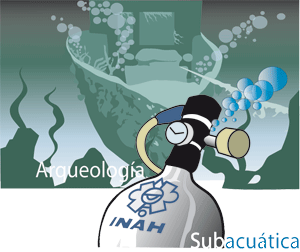WELCOME to MexicoÂ’s Underwater Archaeology site
Here we would like to talk to you about what Underwater Archaeology is, how it began in our country, who are the specialists involved and what its study object is. It is also an invitation to discover, collaborate with and contribute to the scientific study of our past.
MexicoÂ’s waters, whether territorial or continental (rivers, lagoons, springs, cenotes, etc.) cover large areas. In continental waters one can find mainly material culture belonging to the prehispanic groups that lived near these bodies of water and used them as means of survival and as sacred places. The waters of the Pacific Ocean, the Gulf of Mexico and the Caribbean Sea hold an important colonial heritage. This is the reason why in Mexico we call Underwater an not Marine the archaeology which is practiced underwater.
Underwater Archaeology is simply archaeology since it has the same objective: the understanding of human groups which lived before us, and this is achieved by the study of the remains which have been preserved through time and space. Every piece found is a unique fragment for the understanding of that great puzzle we call our history. We are all responsible for the protection of our past, and the best way to do so is by getting to know it. The more we know our past, the more careful we will be not to destroy it. This is the reason why we would like to transmit what our work is about and why it is so fascinating, and, above all, why we are convinced that being in touch with the past makes us stronger as individuals and as nations.
In this site you will be able to navigate freely through the submenus or follow the sequence for each section. We hope you find it interesting and send any comments, questions and suggestions to pluna.cnar@inah.gob.mx.
"Not all our books will perish, our mutilated statues will again be sculpted and other domes and pediments will be born from our pediments and from our domes; some men will think, will work and will feel like us; I dare count on those who will carry on with our work and who are born at regular intervals throughout the centuries, with that intermittent immortality."
—Marguerite Yourcenar
HadrianÂ’s Memoirs
"In few sciences is there such a great gulf between the researcher and its study object as in Archaeology. How can we discover man in all its multi faceted complexity through the few pots, remains of buildings and instruments which time has bequeathed us as witnesses of a humanity whose life dives into the abyss of time? Despite this overwhelming problem, the archaeologist has turned need into a virtue and the development of his science has produced -as Gordon Childe says-; a revolution in history, since it has increased hundred fold the possibility of looking at the past, almost to the same degree of what the telescope has done for the extension of the astronomer's field of vision".
—Roger Bartra
Typology and periodification in archaeological method
-----------------------------
Coordinación Nacional de ArqueologÃa - INAH -
Argentina Núm. 12, Esq. Donceles, Col Centro,
D.F., C.P. 06060
|
| | | |
|